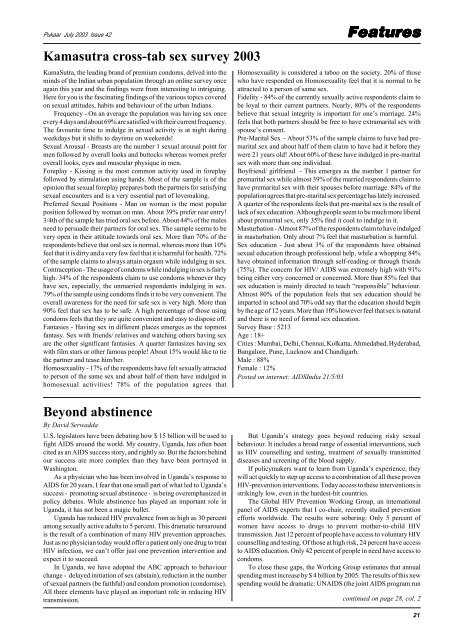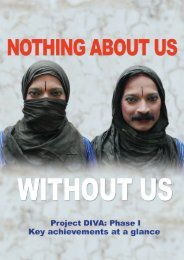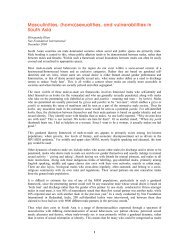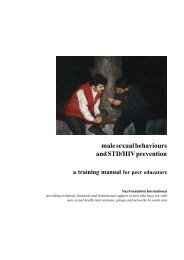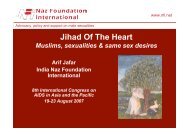Features - Naz Foundation International
Features - Naz Foundation International
Features - Naz Foundation International
You also want an ePaper? Increase the reach of your titles
YUMPU automatically turns print PDFs into web optimized ePapers that Google loves.
Pukaar July 2003 Issue 42<br />
Kamasutra cross-tab sex survey 2003<br />
KamaSutra, the leading brand of premium condoms, delved into the<br />
minds of the Indian urban population through an online survey once<br />
again this year and the findings were from interesting to intriguing.<br />
Here for you is the fascinating findings of the various topics covered<br />
on sexual attitudes, habits and behaviour of the urban Indians.<br />
Frequency - On an average the population was having sex once<br />
every 4 days and about 69% are satisfied with their current frequency.<br />
The favourite time to indulge in sexual activity is at night during<br />
weekdays but it shifts to daytime on weekends!<br />
Sexual Arousal - Breasts are the number 1 sexual arousal point for<br />
men followed by overall looks and buttocks whereas women prefer<br />
overall looks, eyes and muscular physique in men.<br />
Foreplay - Kissing is the most common activity used in foreplay<br />
followed by stimulation using hands. Most of the sample is of the<br />
opinion that sexual foreplay prepares both the partners for satisfying<br />
sexual encounters and is a very essential part of lovemaking.<br />
Preferred Sexual Positions - Man on woman is the most popular<br />
position followed by woman on man. About 39% prefer rear entry!<br />
3/4th of the sample has tried oral sex before. About 44% of the males<br />
need to persuade their partners for oral sex. The sample seems to be<br />
very open in their attitude towards oral sex. More than 70% of the<br />
respondents believe that oral sex is normal, whereas more than 10%<br />
feel that it is dirty and a very few feel that it is harmful for health. 72%<br />
of the sample claims to always attain orgasm while indulging in sex.<br />
Contraception - The usage of condoms while indulging in sex is fairly<br />
high. 34% of the respondents claim to use condoms whenever they<br />
have sex, especially, the unmarried respondents indulging in sex.<br />
79% of the sample using condoms finds it to be very convenient. The<br />
overall awareness for the need for safe sex is very high. More than<br />
90% feel that sex has to be safe. A high percentage of those using<br />
condoms feels that they are quite convenient and easy to dispose off.<br />
Fantasies - Having sex in different places emerges as the topmost<br />
fantasy. Sex with friends/ relatives and watching others having sex<br />
are the other significant fantasies. A quarter fantasizes having sex<br />
with film stars or other famous people! About 15% would like to tie<br />
the partner and tease him/her.<br />
Homosexuality - 17% of the respondents have felt sexually attracted<br />
to person of the same sex and about half of them have indulged in<br />
homosexual activities! 78% of the population agrees that<br />
<strong>Features</strong><br />
Homosexuality is considered a taboo on the society. 20% of those<br />
who have responded on Homosexuality feel that it is normal to be<br />
attracted to a person of same sex.<br />
Fidelity - 84% of the currently sexually active respondents claim to<br />
be loyal to their current partners. Nearly, 80% of the respondents<br />
believe that sexual integrity is important for one’s marriage. 24%<br />
feels that both partners should be free to have extramarital sex with<br />
spouse’s consent.<br />
Pre-Marital Sex - About 53% of the sample claims to have had premarital<br />
sex and about half of them claim to have had it before they<br />
were 21 years old! About 60% of these have indulged in pre-marital<br />
sex with more than one individual.<br />
Boyfriend/ girlfriend - This emerges as the number 1 partner for<br />
premarital sex while almost 39% of the married respondents claim to<br />
have premarital sex with their spouses before marriage. 84% of the<br />
population agrees that pre-marital sex percentage has lately increased.<br />
A quarter of the respondents feels that pre-marital sex is the result of<br />
lack of sex education. Although people seem to be much more liberal<br />
about premarital sex, only 35% find it cool to indulge in it.<br />
Masturbation - Almost 87% of the respondents claim to have indulged<br />
in masturbation. Only about 7% feel that masturbation is harmful.<br />
Sex education - Just about 3% of the respondents have obtained<br />
sexual education through professional help, while a whopping 84%<br />
have obtained information through self-reading or through friends<br />
(75%). The concern for HIV/ AIDS was extremely high with 91%<br />
being either very concerned or concerned. More than 85% feel that<br />
sex education is mainly directed to teach “responsible” behaviour.<br />
Almost 80% of the population feels that sex education should be<br />
imparted in school and 70% odd say that the education should begin<br />
by the age of 12 years. More than 10% however feel that sex is natural<br />
and there is no need of formal sex education.<br />
Survey Base : 5213<br />
Age : 18+<br />
Cities : Mumbai, Delhi, Chennai, Kolkatta, Ahmedabad, Hyderabad,<br />
Bangalore, Pune, Lucknow and Chandigarh.<br />
Male : 88%<br />
Female : 12%<br />
Posted on internet: AIDSIndia 21/5/03<br />
Beyond abstinence<br />
By David Serwadda<br />
U.S. legislators have been debating how $ 15 billion will be used to<br />
fight AIDS around the world. My country, Uganda, has often been<br />
cited as an AIDS success story, and rightly so. But the factors behind<br />
our success are more complex than they have been portrayed in<br />
Washington.<br />
As a physician who has been involved in Uganda’s response to<br />
AIDS for 20 years, I fear that one small part of what led to Uganda’s<br />
success - promoting sexual abstinence - is being overemphasized in<br />
policy debates. While abstinence has played an important role in<br />
Uganda, it has not been a magic bullet.<br />
Uganda has reduced HIV prevalence from as high as 30 percent<br />
among sexually active adults to 5 percent. This dramatic turnaround<br />
is the result of a combination of many HIV prevention approaches.<br />
Just as no physician today would offer a patient only one drug to treat<br />
HIV infection, we can’t offer just one prevention intervention and<br />
expect it to succeed.<br />
In Uganda, we have adopted the ABC approach to behaviour<br />
change - delayed initiation of sex (abstain), reduction in the number<br />
of sexual partners (be faithful) and condom promotion (condomise).<br />
All three elements have played an important role in reducing HIV<br />
transmission.<br />
But Uganda’s strategy goes beyond reducing risky sexual<br />
behaviour. It includes a broad range of essential interventions, such<br />
as HIV counselling and testing, treatment of sexually transmitted<br />
diseases and screening of the blood supply.<br />
If policymakers want to learn from Uganda’s experience, they<br />
will act quickly to step up access to a combination of all these proven<br />
HIV-prevention interventions. Today access to these interventions is<br />
strikingly low, even in the hardest-hit countries.<br />
The Global HIV Prevention Working Group, an international<br />
panel of AIDS experts that I co-chair, recently studied prevention<br />
efforts worldwide. The results were sobering: Only 5 percent of<br />
women have access to drugs to prevent mother-to-child HIV<br />
transmission. Just 12 percent of people have access to voluntary HIV<br />
counselling and testing. Of those at high risk, 24 percent have access<br />
to AIDS education. Only 42 percent of people in need have access to<br />
condoms.<br />
To close these gaps, the Working Group estimates that annual<br />
spending must increase by $ 4 billion by 2005. The results of this new<br />
spending would be dramatic: UNAIDS (the joint AIDS program run<br />
continued on page 28, col. 2<br />
21


